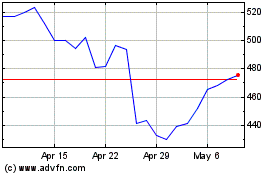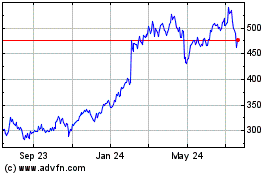By Jack Nicas
" Yoko Ono: 'I Had An Affair With Hillary Clinton In The '70s,'"
read the headline in World News Daily Report, a website that
peddles made-up stories.
Next to the story? An ad for the 2017 Ram 1500 truck, made by
Fiat Chrysler Automobiles NV.
Big brands, often inadvertently, are helping fund the websites
at the center of a growing controversy over misinformation on the
internet.
Ads from companies such as Choice Hotels, SoundCloud and Bose
Corp. appear on sites with false or misleading news. Those
companies are among thousands of brands that could appear on such
sites based on a user's browsing history or demographics.
Industry executives say some fake-news sites can generate tens
of thousands of dollars in monthly revenue from online ads.
Well-known brands' appearance on fake-news sites reflects the
complexity of online advertising, where computers can place a
different ad each time a user clicks on a webpage. Multiple
middlemen are often involved, leaving both publishers and
advertisers uncertain about which ads will appear where.
"We don't even get passed the name of the publisher" where an ad
will appear, said Adam Berke, president of AdRoll Inc., which helps
advertisers like LendingClub Corp. and Air New Zealand place ads
online. He said AdRoll finds ad space on websites through several
partners and doesn't have the resources to vet websites.
One of AdRoll's partners is Alphabet Inc.'s Google, which along
with Facebook Inc. announced steps last month to prevent fake-news
sites from generating revenue through their ad-selling
services.
Google, the biggest player in digital advertising, said it would
stop placing ads on sites with "deceptive or misrepresentative"
content. But so far, enforcement appears spotty: Many Google-placed
ads, including those for big brands, continue to appear on the
sites, even including ads for Google's new Pixel smartphones.
In a statement, Google said, "We're in the process of
implementing the new policy and these early stages have demanded
increased human review."
AppNexus Inc., which runs an online-ad exchange, said it also
tries to not place ads on fake-news sites. Last month, AppNexus
pulled its ads from the right-wing news site Breitbart because of
what it said was hate speech on the site. Some big brands,
including food company Kellog Co. and insurer Allstate Corp., have
blocked their ads from appearing on Breitbart. Breitbart didn't
respond to a request for comment.
In a blog post last month, Dan Greenberg, chief executive of
ad-software firm Sharethrough Inc., urged ad-tech firms to stop
placing ads on fake-news sites.
"Maybe it's true they didn't know. Maybe it's true they didn't
care," Mr. Greenberg said in an interview. "But it's not fair going
forward for that ad company to say they still don't know."
The business model for ad-tech firms is complicated. Depending
on the agreement, they charge advertisers for clicks or views, and
then share that revenue with the websites where their ads appear
and sometimes other middlemen.
Among the big brands whose ads have appeared on sites featuring
fake news, Fiat Chrysler said it uses software that automatically
blocks its ads from appearing on websites with hate speech or adult
content. But the company said there is no "'truth filter'
technology" -- so fake-news websites have to be added one by one to
a blacklist.
SoundCloud said it hasn't tried to block its ads from "fake or
parody news sites" but is now exploring whether it should. Choice
Hotels and Bose didn't respond to requests for comment.
One executive at a large financial-services firm, who declined
to be named, said the company was frustrated to continually find
its ads appearing in dark corners of the internet, including one
near a story on a website called The US Patriot that falsely claims
first lady Michelle Obama didn't give birth to her children.
Attempts to reach The US Patriot and World News Daily Report for
comment were unsuccessful.
The executive said three people manually review a list of
thousands of sites where the company's ads appeared to determine
which are unsuitable. Each month, the company asks Google and other
ad partners to ban dozens of questionable sites, the executive
said, but there are many the team doesn't spot.
Several companies said it is difficult to label a site as a
purveyor of fake news. Even sites that publish almost exclusively
false content, may also include opinion pieces and generally true
stories, albeit with misleading or false headlines.
Augustine Fou, an independent ad-fraud researcher, said the
recent changes are unlikely to force fake-news sites out of
business. Because ad-tech firms make money when ads are shown, they
have little incentive to block any site that shows their ads.
"If you think about their motives, I don't think anyone is in a
hurry," he said.
Another source of revenue for fake-news sites:
content-recommendation widgets. These often include photos of
scantily clad women or grotesque images, with headlines like "15
Models Wearing Nothing But Milk! #13 Is Awesome" and "The Shocking
Truth About Aging Skin."
These widgets, provided by companies such as Taboola, Content.ad
Inc. and Revcontent, appear all over the web -- including on many
legitimate news outlets -- and don't shy away from fake-news
sites.
Taboola didn't respond to requests for comment.
Mike Rosenberg, Content.ad's chief revenue officer, said
employees approve each website that wants to run its widgets, but
"we certainly can't verify the truthfulness of every article."
Revcontent CEO John Lemp said he is skeptical of the push to ban
ads from certain sites, calling it censorship. "Sensational
headlines have been part of journalism for years," he said.
Write to Jack Nicas at jack.nicas@wsj.com
(END) Dow Jones Newswires
December 08, 2016 05:44 ET (10:44 GMT)
Copyright (c) 2016 Dow Jones & Company, Inc.
Meta Platforms (NASDAQ:META)
Historical Stock Chart
From Mar 2024 to Apr 2024

Meta Platforms (NASDAQ:META)
Historical Stock Chart
From Apr 2023 to Apr 2024
